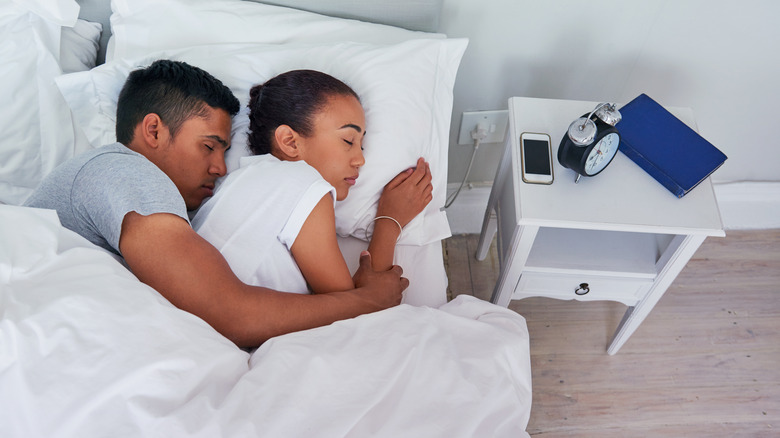Surprising Things Your Sleep Position Reveals About Your Relationship
We may receive a commission on purchases made from links.
Finding a sleep position that allows both you and your partner to feel maximum levels of comfort throughout the night is important, and you've probably realized this whether you're in a longterm relationship or have only recently started sharing a bed. However, what you may not realize is that the position in which you and your significant other sleep with each other actually says quite a lot about the relationship the two of you share. Sure, astrology is fun — but if you really want more insight to exactly how your partner feels about you, all you have to do is observe the position they take next to you when the lights go down.
"The way that we sleep reveals a great deal about our personalities," Evany Thomas, author of The Secret Language of Sleep: A Couple's Guide, explained to the New York Post. She continued, "We spend a third of our time together asleep, and it's where we have our most unguarded moments."
Whether you and your partner are classic spooners or separate sleepers, here's a look at what your preferred sleeping position says about your relationship.
Spooning as a sleep position is a sign of trust and intimacy
The spooning sleep position is pretty self-explanatory. Essentially, two sleeping partners become like a pair of spoons nestled together in a drawer — or, in this case, a bed — with one partner pressing the front of their body against the back of their partner's body. In this aptly-titled sleeping position, the "big spoon," or the person on the outside of the spooning situation, curls their body to match the form of their partner, who is affectionately known as the "little spoon" in this position.
If you and your partner are spooning sleepers, you likely enjoy high levels of both intimacy and trust in your relationship. As Patti Wood, body language expert and author of Success Signals: A Guide to Reading Body Language, explained (via Cosmopolitan), "[Spooning is] a very vulnerable position that's sexual, but says, 'I trust you.'"
According to Sarah Brown, a sleep and wellness expert with Mattress Firm, spooning is more common in newer relationships. "[People] tend to gain more independence the longer they stay in a relationship," Brown explained (via Ask Men).
Lovers who lock legs as a sleep position are peas in a pod
Have your friends ever described you and your partner as being inseparable? Are you able to communicate your thoughts and feelings to your lover with nothing more than a glance? Do you often feel like your partner knows you better than you know yourself? If you answered yes to any of these questions, there's a good chance that your favorite sleep position is the "Leg Hug."
As you've likely gathered from its name, couples who opt for the Leg Hug position literally lock their legs together while they sleep — kind of like how sleeping otters hold hands so they don't float away from one another. According to body language expert Patti Wood, locking legs with your partner during the night likely means that the two of you are an undisputed team.
"[Locking legs] means your lives are intertwined, that you function as a pair," Wood explained (via Little Things). "You probably finish each other's sentences and take care of each other."
The back-to-back sleep position is for couples who enjoy independence
There are few things more exciting than the butterflies-in-your-stomach feeling that comes with the beginning of a new relationship. In this stage, known as the "honeymoon period," your partner feels like a drug — and you simply can't get enough. The two of you are attached at the hip in every sense of the phrase, clinging on to each other both emotionally and physically — even while drifting off to dreamland.
However, the honeymoon period doesn't last forever. As you and your partner grow to feel more comfortable and secure in your relationship, you'll likely realize that — while you're more in love than ever before — you've both gradually come to value personal space and independence over constantly being attached to one another. According to relationship psychologist Corrine Sweet (via Little Things), the sleep position that best represents this dynamic is sleeping back-to-back, while also leaving a bit of space between you and your partner. Called "The Liberty Lovers," Sweet revealed that this position is most often seen in couples who are "connected and secure in themselves."
"This position shows both closeness and independence in the relationship," Sweet explained.
What it means if a partner hogs space with their sleep position
Loving someone means loving them for the imperfect human being they are. Every person has their bad habits and quirks — and whether they intend to or not, they'll likely bring many of these little annoyances into a relationship. Perhaps they never close the milk jug all the way, or maybe they often forget to water the plants. Or, on a more terrifying note, your partner might turn out to be a blanket hog. Cue dramatic music.
Of course, we're kidding. Having your cover stolen from you in the middle of the night is annoying, but blanket hogging is probably not a deal breaker for most couples. However, if your partner consistently hogs the majority of your bed by assuming the starfish sleep position and sprawling across the mattress, leaving you fighting to not fall onto the floor, you might want to reevaluate your relationship.
"One partner dominates the space, while the other takes a secondary role," relationship expert Corrine Sweet said, explaining the dynamic behind this undesirable sleeping position (via Little Things). Unfortunately, if your partner sleeps like an inconsiderate starfish, it could mean they may be selfish.
The Nuzzle sleep position proves the spark's still there
If you usually forego using your pillow in favor of resting your head on your partner's chest, you're basically the human version of the heart-eyes emoji. In other words, sleeping on your partner – rather than simply sleeping beside them — generally means you've either got a big, fat crush or you're head-over-heels in love.
According to relationship expert Corrine Sweet (via Little Things), this position, called "The Nuzzle," is most often seen during the early stages of relationships, when a couple is still basking in the glow of their honeymoon period. Sweet also revealed that ex-lovers who are rekindling a romance may find themselves falling asleep in a nuzzling sleep position.
If you and your partner are nighttime nuzzlers, it's safe to say there's not a lack of romance in your relationship. Nuzzling with your partner also shows a "strengthening sense of comradeship and protection," according to psychologist Shirley Glass (via Little Things).
This sleep position may mean you're too wrapped up in your partner
While relationship experts agree that nuzzling close to your partner as the two of you drift off to dreamland is a sweet display of affection, trust, and protection, there is such a thing as being a bit too close to your sleeping significant other. If you and your partner face each other while in sleep positions, with your noses nearly touching and all of your limbs intertwined, the two of you should probably try and draw a few boundaries within your relationship. This position, called "The Tangle," may seem like an indicator of passion — but, according to psychotherapist Elizabeth Flynn Campbell (via Little Things), it's usually a sign of co-dependency.
As Campbell explained, a couple who consistently sleeps tangled in each others' arms "could be overly enmeshed, [and] too dependent on each other to sleep apart." Of course, it's normal for partners to depend on each other for certain things — but becoming too dependent on your partner will only hurt one or both of you in the long run, especially if the relationship comes to an end.
Having sleep positions on opposite sides of the bed isn't bad
The "Cliffhanger" sleep position, in which two partners face away from each other while sleeping on completely opposite sides of the bed, may seem like the go-to position for couples who just had a big, blowout fight. However, the Cliffhanger is basically just the Liberty Lovers' older, wiser, more confident sister.
According to Evany Thomas, author of The Secret Language of Sleep: A Couple's Guide, couples who opt for the Cliffhanger position generally aren't upset with each other — and they usually aren't in danger of splitting up. Instead, they likely feel incredibly secure in their relationship, and, as a result, they don't feel threatened by their partner's need for personal space. Because, hey, they need it, too!
"It can look like they're in a huge argument, but it's really a couple that has just found a love of personal space," Thomas said, explaining the psychology behind Cliffhanger couples (via the New York Post).
Health and wellness expert Sarah Brown explained (via Ask Men), this position usually signals that two people have "a healthy amount of independence and are secure in their relationship."
The "Lovers Knot" sleep position is the best of both worlds
As observed in "The Tangle," being too wrapped up in your partner each night might be a sign that the two of you are heading down a dangerous highway of co-dependency. With that said, sleeping while entangled in your lover's arms isn't always a bad thing — as long as you and your partner eventually unravel yourselves.
Referred to by relationship experts as both the "Unraveling Knot" and "Lovers' Knot," this sleep position is a win-win for both parties. As relationship psychologist Corrine Sweet explained (via Little Things), "[This position is] a compromise between intimacy and independence, allowing for the best of both worlds."
Couples who sleep in the Lovers' Knot position fall asleep while wrapped in each other's arms — however, as the night progresses, they gradually untangle themselves, usually ending up in a far less intertwined position. According to Sweet's research, the Lovers' Knot signifies a much stronger bond than The Tangle alone — however, only 8 percent of couples actually prefer this two-step position.
If you find yourself in the "Chasing Spoon" sleep position, it's time to talk
In the "Chasing Spoon" position, the two sleeping partners (or "spoons") are technically in the classic spooning form — both laying on their sides, with the little spoon curled into fetal position. However, the little spoon has pushed themselves to the edge of their side of the bed, and the big spoon, a.k.a. the chasing spoon, has, well, chased them there — pressing their body against that of the little spoon's. According to Samuel Dunkell, author of Goodbye Insomnia, Hello Sleep, he sometimes refers to this position as "Illegal Spooning" (via Redbook). Awkward.
If you see that your little spoon partner is running away from you in bed, it's probably time to have a serious conversation. "The chaser perhaps senses something is amiss but is too nervous to verbally ask what's going on. They are non-verbally making emotional contact," sleep psychologist Hope Bastine explained about the sleep position (via The Telegraph). "If this is happening, then it's time for a tête-à-tête."
Holding hands (or feet) as a sleep position shows a respect for personal space
If you and your partner aren't big on cuddling, it doesn't mean your relationship is doomed or anything less than healthy and loving. There are plenty of reasons why sleeping partners might prefer sleep positions that allow for generous amounts of personal space. Perhaps you're an active sleeper and want to avoid sucker punching your partner while they doze. Maybe your body turns into a human furnace at night — or maybe you just have a strong appreciation for wide, open spaces. Whatever your reason may be, the only thing that matters is that you and your partner are both comfortable and well-rested in the morning.
If hardcore cuddling isn't your thing, it's possible that you still like to maintain physical contact with your partner by holding their hand or intertwining your foot with theirs. According to body language expert Maryann Karinch, this position is for couples who share a strong bond with each other, but don't feel the need to cling on to one another throughout the night. "It's just a brief way of saying, 'We're connected,'" Karinch explained (via Well and Good).
Sleeping in separate beds doesn't mean what you might think
Sleeping in separate beds likely sounds like a death sentence for a relationship, but that's not always the case – and it's not as rare as you might think. According to the National Sleep Foundation, as reported by Today, nearly one in four Americans sleep away from their partners in separate beds and/or bedrooms.
Wellness consultant Hilary Thompson revealed to Bustle that the major concern with couples who sleep separately is that they'll adopt that separateness into other aspects of their relationship. "They are missing out on an important bonding moment with their partner," Thompson revealed of separate sleepers.
However, if your partner's bedtime behavior prevents you from getting a good night's rest, sleeping in another room is likely a good move for your relationship. Tamara Green, a New York-based couples therapist, explained to Today that she's witnessed this type of sleeping arrangement vastly improve the connection between partners. "They get enough rest and they feel like they are able to hear each other out and get their needs met," Green revealed. However, couples who opt for this sleep position arrangement should schedule regular date nights and set time for intimacy.
The "Pillow Talk" sleep position is all about communication
Couples who partake in the "Pillow Talk" sleep position face each other while they sleep, usually with only a small amount of space between them, which creates ample opportunity for ever-important communication. However, Pillow Talk is one of the rarest positions to see among sleeping partners. According to psychologist Richard Wiseman, who led a sleep position study for the Edinburgh International Science Festival, only four percent of couples are Pillow Talk sleepers.
According to Evany Thomas, author of The Secret Language of Sleep: A Couple's Guide, snoozing with your partner in the Pillow Talk position is a great starting point if you're hoping to grow closer and strengthen your relationship. As the name of the position implies, Pillow Talk encourages a bit of bedtime chitchat with your partner, which creates opportunity for the two of you to voice your thoughts and talk about your respective days while feeling both physically and emotionally close with your lover. "The sounds of your bedmate's most fundamental inner workings reveal a great deal about what's most troubling or pleasing him or her," Thomas explained (via New York Post).
The Top-to-Tail sleep position is a sleep fail
Perhaps the strangest of all the various ways you can snooze with your partner is the "Top-to-Tail" sleep position. As you've likely gathered from its name, this unfavorable position happens when one partner sleeps with their head at the foot of the bed, while the other sleeps with their head at the headboard — meaning each partner is sleeping next to the other person's feet.
According to sex expert Tracey Cox, sleeping with your partner in the Top-to-Tail position is pretty much the worst rest-related choice you could make for your relationship. The sex expert revealed to the Daily Mail that Top-to-Tail is the worst of all the sleeping positions you could try with a partner, and is usually indicative of a couple who is either "post-argument or pre-divorce." Understandably, sleeping with a face full of your partner's feet doesn't exactly inspire feelings of romance and closeness. That is, of course, unless feet are something you enjoy. Hey, we're not judging!













